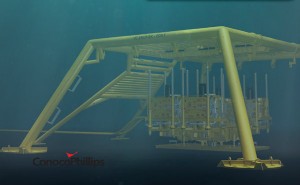The Ekofisk Complex comprises all installations which are connected with bridges on the central Ekofisk field. As of 2018, this includes nine platforms and bridge supports. The newest platforms are the wellhead platform 2/4 Z and the field center and accommodation platform 2/4 L which were installed in 2013.

Since the development started early in the 1970s, the Complex has been a field center and hub for the production from the Ekofisk field itself, and from the other fields in the Greater Ekofisk Area. In addition, production from other fields in the area has been - and is - transported via the Ekofisk Complex to the receiving terminals in Emden, Germany (gas) and Teesside, UK (oil).
The Ekofisk Complex has been developed in stages, and upgraded and modernized several times.
The latest redevelopment, Ekofisk South, startet operation in 2013. The Ekofisk South project consists of the 2/4 Z wellhead platform and the 2/4 VB seabed installation.
For press photos, click here.


 2/4 J is a hub for all production from the four fields in the Greater Ekofisk Area. In addition to the production from the main field Ekofisk, oil and gas from Eldfisk and Embla is also transported to Ekofisk 2/4 J.
2/4 J is a hub for all production from the four fields in the Greater Ekofisk Area. In addition to the production from the main field Ekofisk, oil and gas from Eldfisk and Embla is also transported to Ekofisk 2/4 J. to the platforms Ekofisk 2/4 C and Ekofisk 2/4 J via gangways.
to the platforms Ekofisk 2/4 C and Ekofisk 2/4 J via gangways.
 cabins. It is no longer in regular use.
cabins. It is no longer in regular use. platform on the Ekofisk Complex. The platform is permanently staffed with operations personnel. It has gangway connections to Ekofisk 2/4 H, Ekofisk 2/4 Q and Ekofisk 2/4 X.
platform on the Ekofisk Complex. The platform is permanently staffed with operations personnel. It has gangway connections to Ekofisk 2/4 H, Ekofisk 2/4 Q and Ekofisk 2/4 X. quarters platform with a helicopter deck and offices. The platform was shut down in 2014.
quarters platform with a helicopter deck and offices. The platform was shut down in 2014. Ekofisk 2/4 L is an accommodation and field center platform in the Ekofisk Complex.
Ekofisk 2/4 L is an accommodation and field center platform in the Ekofisk Complex. 36 well slots, 35 of which are for production and one is dedicated to the reinjection of cuttings. The wells will be drilled by a jack up drilling rig placed next to the 2/4 Z-platform.
36 well slots, 35 of which are for production and one is dedicated to the reinjection of cuttings. The wells will be drilled by a jack up drilling rig placed next to the 2/4 Z-platform.
 The injection water comes from Ekofisk 2/4 K and is sent 4.1 kilometers through a pipeline before being injected under high pressure at the wellhead, around 70 meters below sea level.
The injection water comes from Ekofisk 2/4 K and is sent 4.1 kilometers through a pipeline before being injected under high pressure at the wellhead, around 70 meters below sea level. located three kilometers south of the Ekofisk Complex. The water injection takes place using a five-kilometer pipeline from the Eldfisk Complex to Ekofisk 2/4 VB. The unit is connected to the corresponding seabed unit Ekofisk 2/4 VA by hydraulic and fiber optic cables.
located three kilometers south of the Ekofisk Complex. The water injection takes place using a five-kilometer pipeline from the Eldfisk Complex to Ekofisk 2/4 VB. The unit is connected to the corresponding seabed unit Ekofisk 2/4 VA by hydraulic and fiber optic cables.  Ekofisk 2/4 VB is a seabed unit with four water injection wells – located approximately three kilometers south of the Ekofisk Complex.
Ekofisk 2/4 VB is a seabed unit with four water injection wells – located approximately three kilometers south of the Ekofisk Complex.